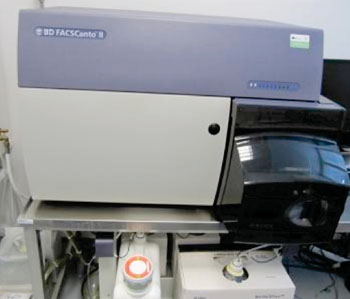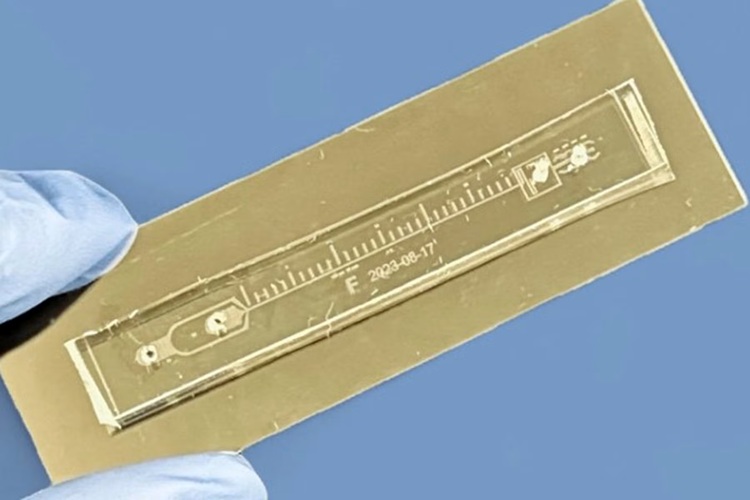Flow Cytometry Detects Lymphoproliferative Disorders in Fluid Specimens
|
By LabMedica International staff writers Posted on 26 Aug 2014 |

Image: The fluorescence-activated cell sorting FACSCanto II flow cytometer (Photo courtesy of BD Biosystems).
Immunophenotypic analysis of hematopoietic cell populations by flow cytometry has emerged as a useful ancillary study in the diagnostic evaluation of serous effusions and cerebrospinal fluids (CSFs).
The evaluation of lymphoid proliferations in these specimens can be particularly problematic, given the frequent presence of coexisting inflammatory conditions and the manner in which these specimens are processed.
Laboratory scientists at the Hospital of the University of Pennsylvania (Philadelphia, PA, USA) searched for all serous effusions specimens such as pleural fluid, peritoneal fluid, and pericardial fluid, and CSF specimens in which flow cytometry was performed, during the time period June 2008 to July 2012. Six-color flow cytometry was performed according to the manufacturer's protocol on a FACSCanto II flow cytometer (BD Biosystems; San Jose, CA, USA). A panel using different antibodies from Becton Dickinson Immunocytometry Systems, (San Jose, CA, USA) was utilized.
Flow cytometry was performed in 184 of 6,925 total cases (2.7% of all fluids). Flow cytometry was performed in 4.8% of pleural fluids (positive findings in 38%, negative in 40%, and atypical in 18%), 1.1% of peritoneal fluids (positive in 40%, negative in 50%, and atypical in 10%), 1.9% of pericardial fluids (positive in 67%, negative in 33%), and 1.9% of CSFs (positive in 23%, negative in 55%, atypical in 3%).
The authors concluded that atypical flow cytometry findings and atypical morphologic findings in the context of negative flow cytometry results led to the definitive diagnosis of a lymphoproliferative disorder in a significant number of cases when repeat procedures and ancillary studies were performed. Flow cytometry is especially suited for cells in fluid specimens, where aggregates of cells and extracellular matrix elements that may interfere with obtaining single cells for analysis are less prominent than in solid tissue specimens. In addition, it is well known to increase the sensitivity of detecting neoplastic populations of cells over morphology alone. The study was published in the August 2014 issue of the journal Diagnostic Cytopathology.
Related Links:
Hospital of the University of Pennsylvania
BD Biosystems
Becton Dickinson
The evaluation of lymphoid proliferations in these specimens can be particularly problematic, given the frequent presence of coexisting inflammatory conditions and the manner in which these specimens are processed.
Laboratory scientists at the Hospital of the University of Pennsylvania (Philadelphia, PA, USA) searched for all serous effusions specimens such as pleural fluid, peritoneal fluid, and pericardial fluid, and CSF specimens in which flow cytometry was performed, during the time period June 2008 to July 2012. Six-color flow cytometry was performed according to the manufacturer's protocol on a FACSCanto II flow cytometer (BD Biosystems; San Jose, CA, USA). A panel using different antibodies from Becton Dickinson Immunocytometry Systems, (San Jose, CA, USA) was utilized.
Flow cytometry was performed in 184 of 6,925 total cases (2.7% of all fluids). Flow cytometry was performed in 4.8% of pleural fluids (positive findings in 38%, negative in 40%, and atypical in 18%), 1.1% of peritoneal fluids (positive in 40%, negative in 50%, and atypical in 10%), 1.9% of pericardial fluids (positive in 67%, negative in 33%), and 1.9% of CSFs (positive in 23%, negative in 55%, atypical in 3%).
The authors concluded that atypical flow cytometry findings and atypical morphologic findings in the context of negative flow cytometry results led to the definitive diagnosis of a lymphoproliferative disorder in a significant number of cases when repeat procedures and ancillary studies were performed. Flow cytometry is especially suited for cells in fluid specimens, where aggregates of cells and extracellular matrix elements that may interfere with obtaining single cells for analysis are less prominent than in solid tissue specimens. In addition, it is well known to increase the sensitivity of detecting neoplastic populations of cells over morphology alone. The study was published in the August 2014 issue of the journal Diagnostic Cytopathology.
Related Links:
Hospital of the University of Pennsylvania
BD Biosystems
Becton Dickinson
Latest Immunology News
- Chip Captures Cancer Cells from Blood to Help Select Right Breast Cancer Treatment
- Blood-Based Liquid Biopsy Model Analyzes Immunotherapy Effectiveness
- Signature Genes Predict T-Cell Expansion in Cancer Immunotherapy
- Molecular Microscope Diagnostic System Assesses Lung Transplant Rejection
- Blood Test Tracks Treatment Resistance in High-Grade Serous Ovarian Cancer
- Luminescent Probe Measures Immune Cell Activity in Real Time
- Blood-Based Immune Cell Signatures Could Guide Treatment Decisions for Critically Ill Patients
- Novel Tool Predicts Most Effective Multiple Sclerosis Medication for Patients
- Companion Diagnostic Test for CRC Patients Identifies Eligible Treatment Population
- Novel Tool Uses Deep Learning for Precision Cancer Therapy
- Companion Diagnostic Test Identifies HER2-Ultralow Breast Cancer and Biliary Tract Cancer Patients
- Novel Multiplex Assay Supports Diagnosis of Autoimmune Vasculitis
- Blood Test Predicts Immunotherapy Efficacy in Triple-Negative Breast Cancer
- Simple Genetic Testing Could Predict Treatment Success in Multiple Sclerosis Patients
- Novel Gene Signature Predicts Immunotherapy Response in Advanced Kidney Cancers
- New Technology Deciphers Immune Cell Communication to Predict Immunotherapy Response
Channels
Clinical Chemistry
view channel
Chemical Imaging Probe Could Track and Treat Prostate Cancer
Prostate cancer remains a leading cause of illness and death among men, with many patients eventually developing resistance to standard hormone-blocking therapies. These drugs often lose effectiveness... Read more
Mismatch Between Two Common Kidney Function Tests Indicates Serious Health Problems
Creatinine has long been the standard for measuring kidney filtration, while cystatin C — a protein produced by all human cells — has been recommended as a complementary marker because it is influenced... Read moreMolecular Diagnostics
view channel
New Genetic Test Enables Faster Diagnosis of Rare Diseases
Rare disease diagnosis often involves a long and uncertain search for the underlying genetic cause. Traditional testing requires multiple separate analyses, although many patients remain without answers.... Read more
Urine Test Detects Inherited Neuropathy Missed by Genetic Screening
Sorbitol dehydrogenase (SORD)-related neuropathy is one of the most common inherited nerve disorders, yet diagnosis often lags because current genetic screens frequently miss the causal gene.... Read moreHematology
view channel
Platelet Activity Blood Test in Middle Age Could Identify Early Alzheimer’s Risk
Early detection of Alzheimer’s disease remains one of the biggest unmet needs in neurology, particularly because the biological changes underlying the disorder begin decades before memory symptoms appear.... Read more
Microvesicles Measurement Could Detect Vascular Injury in Sickle Cell Disease Patients
Assessing disease severity in sickle cell disease (SCD) remains challenging, especially when trying to predict hemolysis, vascular injury, and risk of complications such as vaso-occlusive crises.... Read more
ADLM’s New Coagulation Testing Guidance to Improve Care for Patients on Blood Thinners
Direct oral anticoagulants (DOACs) are one of the most common types of blood thinners. Patients take them to prevent a host of complications that could arise from blood clotting, including stroke, deep... Read moreMicrobiology
view channel
Rapid Assay Identifies Bloodstream Infection Pathogens Directly from Patient Samples
Bloodstream infections in sepsis progress quickly and demand rapid, precise diagnosis. Current blood-culture methods often take one to five days to identify the pathogen, leaving clinicians to treat blindly... Read more
Blood-Based Molecular Signatures to Enable Rapid EPTB Diagnosis
Extrapulmonary tuberculosis (EPTB) remains difficult to diagnose and treat because it spreads beyond the lungs and lacks easily accessible biomarkers. Despite TB infecting 10 million people yearly, the... Read more
15-Minute Blood Test Diagnoses Life-Threatening Infections in Children
Distinguishing minor childhood illnesses from potentially life-threatening infections such as sepsis or meningitis remains a major challenge in emergency care. Traditional tests can take hours, leaving... Read more
High-Throughput Enteric Panels Detect Multiple GI Bacterial Infections from Single Stool Swab Sample
Gastrointestinal (GI) infections are among the most common causes of illness worldwide, leading to over 1.7 million deaths annually and placing a heavy burden on healthcare systems. Conventional diagnostic... Read morePathology
view channel
Blood Test and Sputum Analysis Predict Acute COPD Exacerbation
Chronic obstructive pulmonary disease (COPD) remains a major contributor to global illness, largely driven by cigarette smoking and marked by irreversible lung damage. Acute exacerbations can accelerate... Read more
AI Tool to Transform Skin Cancer Detection with Near-Perfect Accuracy
Melanoma continues to be one of the most difficult skin cancers to diagnose because it often resembles harmless moles or benign lesions. Traditional AI tools depend heavily on dermoscopic images alone,... Read more
Unique Immune Signatures Distinguish Rare Autoimmune Condition from Multiple Sclerosis
Myelin oligodendrocyte glycoprotein antibody–associated disease (MOGAD) is a rare autoimmune disorder in which the immune system attacks the myelin sheath in the central nervous system. Although symptoms... Read moreTechnology
view channel
AI Saliva Sensor Enables Early Detection of Head and Neck Cancer
Early detection of head and neck cancer remains difficult because the disease produces few or no symptoms in its earliest stages, and lesions often lie deep within the head or neck, where biopsy or endoscopy... Read more
AI-Powered Biosensor Technology to Enable Breath Test for Lung Cancer Detection
Detecting lung cancer early remains one of the biggest challenges in oncology, largely because current tools are invasive, expensive, or unable to identify the disease in its earliest phases.... Read moreIndustry
view channel
Abbott Acquires Cancer-Screening Company Exact Sciences
Abbott (Abbott Park, IL, USA) has entered into a definitive agreement to acquire Exact Sciences (Madison, WI, USA), enabling it to enter and lead in fast-growing cancer diagnostics segments.... Read more






















